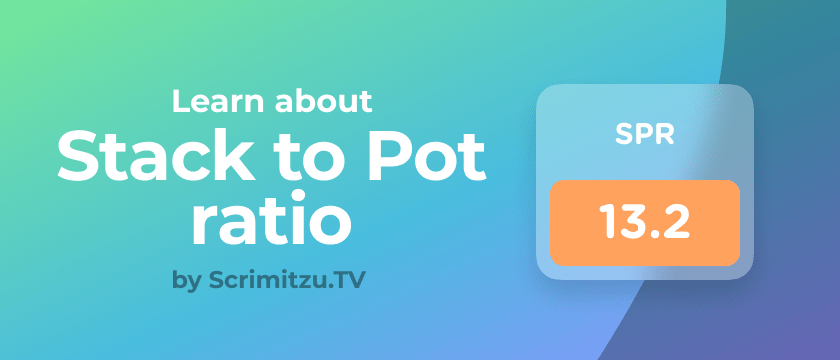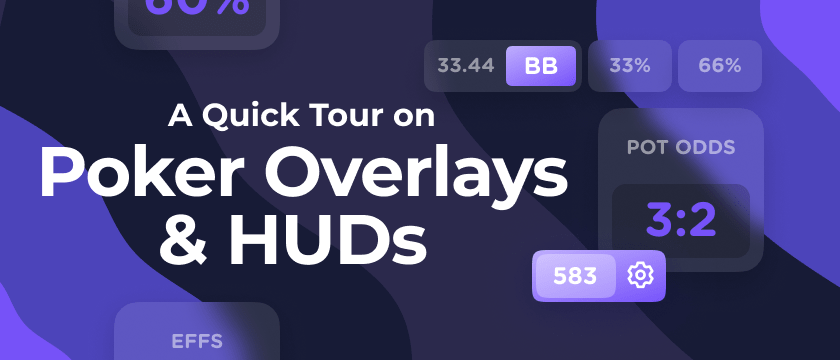In the fast-paced realm of online poker, manually calculating the SPR (Stack to Pot Ratio) in real-time can often be a daunting task, especially for beginners. But what if there was a tool to automate this for you?
Enter Jurojin software — your real-time overlay that effortlessly computes SPR, letting you focus on the game. This elusive metric plays a pivotal role in shaping your in-game decisions, particularly when deciding the strength of the hand needed to commit to a pot.
In this guide, we'll demystify the concept of "SPR in poker" for you. Here's what you can anticipate:
- The Fundamentals of SPR: A clear, concise breakdown of what SPR is and why it's such a game-changer in poker.
- Practical Importance: We'll delve into why mastering SPR can be your secret weapon to magnify winnings and make more informed decisions.
- Tailored Strategies: Aligning your game with the right SPR insights to optimize your gameplay.
👉If you would simply like to activate the SPR HUD in Jurojin, check out our video tutorial here.
How to Calculate SPR in Poker?
SPR, representing the Stack to Pot Ratio, is a straightforward metric in poker achieved by dividing the Smallest Stack (Also known as the “Effective Stack”), in play by the total amount in the pot.
Illustratively, consider a scenario where we reach a flop with the total pot amounting to $10, there are two players in the hand: the button (with a $50 stack) and the big blind (with a $100 stack). Here, the stack to pot ratio would be 5.
What's the Formula to Calculate SPR?
SPR = Effective Stack / Total PotWhile the calculation of SPR is simplistic, its application within the game can be complex and offer nuanced strategies for savvy gameplay. Now, let’s delve deeper into the multifaceted utility of SPR on the poker tables.
How to Manipulate the SPR?
Based on the type of hand you hold preflop, it's essential to understand the SPR that will maximize the EV (Expected Value) of your post-flop play, or determine if playing your hand is even profitable. There are two primary strategies to achieve this:
- Adjust Your Preflop Raise Size
- Don’t Enter the Pot
Adjust Your Preflop Raise Size:
With high equity hands, that may have less playability post flop, such as AKo consider raising larger when you open. For example if we have 50BB effective stacks and we raise to 6BB preflop, rather than 3BB, we get an SPR on the flop of ~3 vs. ~6.
This makes a big difference for when we flop our top pair and have a much easier decision to stack off at an SPR of 3 vs. 6.
Don’t Enter the Pot
In essence, if you anticipate a low SPR after the flop, it's advisable to avoid entering the pot with hands like 44. This is because you'll be locked into a hand with limited bluffing opportunities, and the all-in scenario could arise rapidly.
How SPR Ranges Impact Your Strategy
Having grasped the method of calculating and manipulating SPR, you can now transition into strategizing how to wield this insight proficiently within the game. The SPR often serves as a compass, guiding which hands you continue with and the level of aggression you employ in playing those hands.
It essentially acts as a barometer, signifying how robust your hand ought to be to continue confidently. Let's envision an extreme scenario: The pot stands at $1 on the turn, and the opponent goes all-in with a $100 bet.
Contemplate the hands you would call with in this circumstance as opposed to a scenario where the villain makes a $1 bet into a $100 pot on the same street.
Here are some more realistic scenarios and professional tips tailored for navigating varying SPR scenarios adeptly:
High SPR (Greater Than 10):
Let’s say that we raise to 3BB from the Button with K♠ K♣ and get called from the Big Blind. The flop comes down 9♥9♦7♥ with 97BB effective stacks in play, and an SPR of 15 or less.
We C-bet for 3BB and Villain check raises to 12BB. Here we should just call as we do not have the required Equity / Hand Strength to stack off on the flop. We are also in position and can utilize this advantage on the turn on a dynamic board.
When playing in high SPR situations consider the below before making decisions:
- Play Cautiously Out of Position: High SPR scenarios may put you into challenging situations, particularly by the in-position player who possesses the leverage to introduce sizeable bets on the turn and river. It's prudent to adopt a more restrained strategy, aiming to pot control, particularly with non-nutted hands.
- Fast-Play Your Strongest Hands: In instances where you find yourself this deep, it's imperative to extract value from your strongest hands through betting/raising. A slow play approach may inhibit the potential to get all the chips in the center without resorting to significant over-bet by the time the river is reached.
- Prioritize Realizability Over Raw Equity: Given the sizable stacks at your disposal for leverage, it's advisable to tilt your range towards hands that have the potential to become very strong hands, as opposed to those that may hold an equity advantage on the flop but struggle to play for stacks by the river.
- Blockers Hold More Value: With larger stacks to leverage you are able to apply more pressure on your opponent when blocking the nuts, and put his bluff catchers to a real test.
Low SPR (Less Than 5):
Let’s consider our prior example where we manipulated the SPR by raising to 6BB preflop from EP (Early Position) with A♠ K♣ and get called by the Button with remaining Effective Stacks of 44BB. The flop comes T♠ 9♦ A♥ and we have an SPR of ~3.
We C-bet for 4BB and the Button shoves. Here we have an easy call with Top Pair & Top Kicker at a low SPR. Had we raised smaller preflop this may have been a tougher decision. Here are some considerations to keep in mind in low SPR situations:
- Positional Advantage is Worth Less: The detriments of being out of position are notably mitigated in a low SPR scenario. Given that you are more likely to be all-in on the flop or turn, for instance, you'll find yourself navigating fewer streets out of position.
- Engage in More Slow Plays: The lower SPR provides a conducive environment to slow play strong hands. Despite unfavorable runouts, folding isn't a likely option given the equity required. Moreover, missing one street of value will still not prevent you from playing for stacks.
- Raw Equity Takes Center Stage: The importance of your made hand's absolute strength increases as realizing your full equity becomes more feasible. Concerns surrounding the dynamics of turns and rivers are often sidelined in this case.
- Opt for Smaller Bet Sizes: There's no necessity to funnel a large sum into the pot; consider employing smaller bet or raise amounts. This allows you to keep bluffs in your range without pot committing yourself, while still having the option to comfortably play for stacks.
- Increase Your Check Raises: The reduced stack off equity requirement allows you to check / raise more aggressively. Opponents might overlook adjusting to your stack size, maintaining their c-bet frequency and sizing. Seize this opportunity to employ check raises, penalizing their oversight.
- Grasp Your Stack Off Equity Requirement: It's pivotal to comprehend the equity mandated at each SPR level within this bracket. You'll frequently encounter all-in determinations on flops and turns due to the stack sizes in play, making a well-informed equity assessment crucial. See our SPR poker charts below.
Medium SPR (Between 5 & 10):
- Strategies Will Be More Mixed: In the medium SPR situations actions will be a blend of the low and high SPR scenarios described above and more reliant on the specific situation and opponent.
- Against Tight Opponents: Look to adapt medium SPR situations more towards how you would play in deeper scenarios, requiring stronger hands to stack off.
- Against Looser Opponents: You can fast play more marginal hands, and lower your required hand strength towards the low SPR ranges knowing that they are going to stack off lighter.
Useful Cheat Sheats to Keep Close
We understand it might be hard to track every spot and every number and for that reason we bring you a couple of Cheat Sheets you can save to check when multi tabling.
Hand Strength Calling Ranges by SPR:
You can keep this Cheat Sheet close and consult it when you have doubts regarding a potential Call.
| SPR | Minimum hand to Call |
|---|---|
| 1 | Any Pair/A high+overcards/Any draw above a gutshot |
| 2 | Bottom pair/Any draw above a gutshot |
| 3 | 2nd Pair Weak Kicker / Any Draw above a gutshot |
| 4 | Top Pair Weak Kicker/2nd Pair Top Kicker |
| 6 | Top Pair Good Kicker |
| 8 - 10 | Top Pair Top Kicker |
Using an SPR HUD for Multitabling
When multitabling you’re likely to encounter several challenges, including:
- Reduced time to make decisions
- Reduced concentration and faster mental fatigue
- Surface-level thinking
In such scenarios, it becomes crucial to free up as much time and mental bandwidth as possible. Employing Overlays to eliminate manual calculations and streamline thought processes is imperative for success, and SPR considerations are no exception.
Though the calculation appears simple, sparing yourself the task and having the ability to quickly scan all your tables to instantly grasp the SPR and its implications on your decisions is invaluable. Utilizing tools to automatically handle the SPR aspect can significantly enhance your multitabling efficiency, leaving you more focused on devising winning strategies across different gameplay situations.
Key Takeaways About Stack to Pot Ratio:
- Understanding SPR: The Stack to Pot Ratio is essential for guiding your decisions in poker, determining how deeply committed you are to a pot.
- Strategic Adaptability: Depending on the SPR, your approach—from cautious play to aggressive moves—should vary.
- High vs. Medium vs. Low SPR: Different SPR scenarios dictate distinct strategies. Recognize when to pot control, when to maximize value, and when raw equity becomes paramount.
- Preflop Decisions Impact SPR: The hands you choose to play and your preflop raise sizes can manipulate the SPR, affecting post-flop strategies.
- Jurojin HUDs Advantage: Eliminate the complexities of manual SPR calculations. By using Jurojin overlays, you can instantly assess SPR across tables, allowing you to adapt your strategy swiftly and efficiently.


![Pot Odds HUD: Guide for Online Poker [2024]](/faqs/pot-odds.png)












































